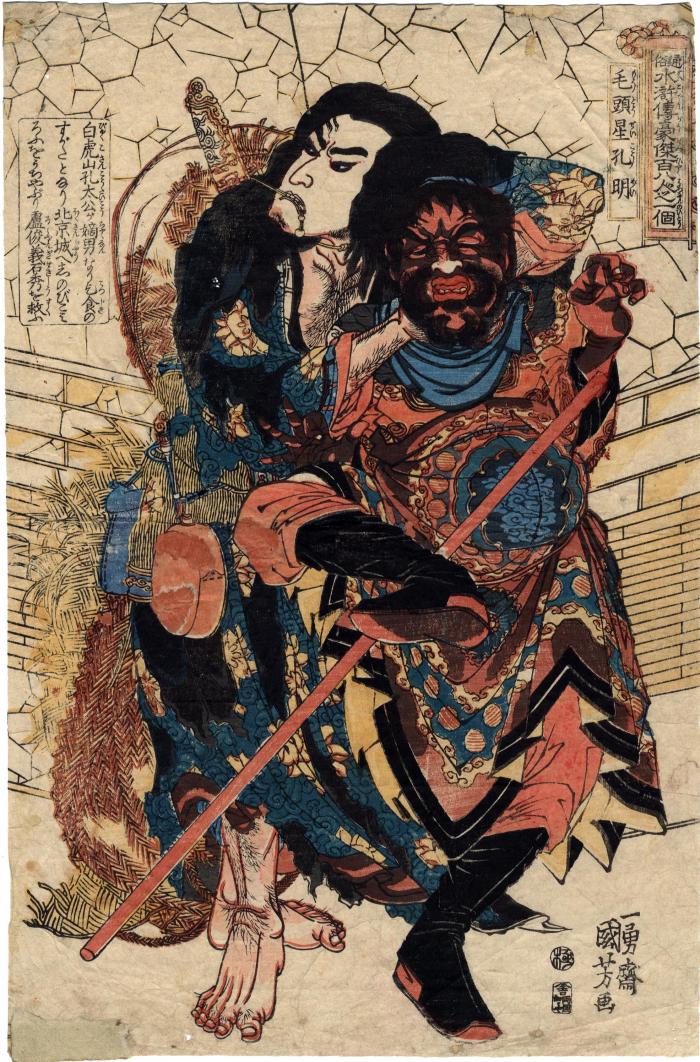Utagawa Kuniyoshi (歌川国芳) (artist 11/15/1797 – 03/05/1861)
Kong Ming, the Comet (Mōtōsei Kōmei - 毛頭星孔明) from One Hundred and Eight Heroes of the Popular Shuihuzhuan (Tsūzoku Suikoden gōketsu hyakuhachinin no hitori - 通俗水滸伝豪傑百八人之一個) - right panel of a diptych
ca 1827 – 1830
9.75 in x 14.75 in (Overall dimensions) Japanese woodblock print
Signed: Ichiyūsai Kuniyoshi ga
一勇斎国芳画
Publisher: Kagaya Kichiemon (Marks 194)
Censor's seal: kiwame
Museum of Fine Arts, Boston
British Museum - there are two copies in this collection
Library of Congress - the full diptych
Lyon Collection - left sheet of this diptych
National Museums of Scotland
Tokyo National Museum
Royal Museums of Art and History, Belgium (via Cultural Japan)
Museum für Ostasiatische Kunst, Köln Inge Klompmakers wrote about this print:
"Together with his younger brother Dokukasei Kōryō..., Mōtōsei Kōmei is the leader of a robber gang on White tiger [sic] mountain (J. Byakkozan). When Kōmei is captured by general Sōben Koenshaku in chapter 56, Kōryō appeals to Kohōgi Sōkō for help. Disguised as imperial soldiers, the Ryōsanpaku rebels enter Peking where Kōmei is imprisoned and free him. Thereafter the brothers of White tiger [sic] mountain join Sōkō's legion."
"Kōmei's portrait comprises the right sheet of a diptych with Dokukasei Kōryō and Unrikongō Sōman depicted in the left. Kuniyoshi's diptych recounts the moment in chapter 65 when the Ryōsanpaku brigands advance on Peking during the Feast of lanterns [sic?] in order to liberate Gyokukirin Roshungi... Henmaisanrō Sekishū... In this sheet, Kōryō and Sōman are still outside the city walls and are attempting to force their way in. Kōmei, dressed as an itinerant in a worn straw cape, is strangling a guard."
****
The British Museum description of this print states: "Kong Ming dressed in a straw cape, strangling a guard outside the walls of Peking."
****
Kong Ming is first mentioned in Chapter 32 of the Chinese version of the marsh brigands. He is the older brother of Kang Liang - represented in the Lyon Collection by two copies of the same print, #s 1287 and 1005.
The text tells us that Squire Kong is the lord of a place called White Tiger Mountain where he has a manor. "The young fellow you fought is his youngest son. Because he's hot-tempered and belligerent he's known as Kong Liang the Flaming Star. The one in the gosling yellow tunic is the squire's eldest son. His name is Kong Ming, and he's called the Comet. Both are fond of spears and staves..."
****
This is the right-hand panel of a Suikoden diptych.
****
Illustrated in a full-page, color reproduction in Of Brigands and Bravery: Kuniyoshi's Heroes of the Suikoden by Inge Klompmakers, Hotei Publishing, 1998, #43a, page 141.
warrior prints (musha-e - 武者絵) (genre)
Suikoden (水滸傳) (genre)
Kagaya Kichiemon (加賀屋吉右衛門) (publisher)
